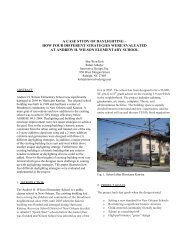SOLAR TODAY - May 2011 - Innovative Design
SOLAR TODAY - May 2011 - Innovative Design
SOLAR TODAY - May 2011 - Innovative Design
You also want an ePaper? Increase the reach of your titles
YUMPU automatically turns print PDFs into web optimized ePapers that Google loves.
istrative barriers across all agencies added more<br />
than $5,000 to $6,000 to the cost of each residential<br />
PV installation in the city, CUNY’s solar<br />
ombudsman began holding office hours at the<br />
city Department of Buildings last September.<br />
Ginsburg facilitated and streamlined applications<br />
for property tax abatement (the city’s financial<br />
incentive for solar) across permitting agencies<br />
and educated installers. This simple step resulted<br />
in a sixfold increase in approved applications.<br />
“Solar installations in the city of New York<br />
have more than doubled over the last year, and<br />
we now have approximately 5.65 megawatts<br />
installed. Better access to information is the<br />
key, and the city has developed a suite of tools<br />
to help both customers and those involved in<br />
the process,” said Tria Case, CUNY’s university<br />
director of sustainability.<br />
She is referring to a solar map that provides<br />
precise information about the size, angle and<br />
shading of rooftops, providing customers and<br />
installers the ability to quickly calculate the size<br />
of a potential solar energy system. A second tool<br />
the city is developing is an interactive installation<br />
guide to help consumers map out their paths<br />
through the process. A third project in the works<br />
is a web-based tool that will allow relevant agencies<br />
to virtually track the progress of each installation,<br />
which will also increase transparency and<br />
clarity for end-users.<br />
Portland Helps Standardize State Permitting.<br />
Portland’s Bureau of Development Services<br />
(BDS) developed an electronic permit submittal<br />
process for solar installers, enabling installers<br />
to e-mail the permit application to the city<br />
and expect a review for qualified projects within<br />
approximately four working days. This process<br />
eliminated an average office wait of three hours,<br />
plus travel time, for contractors. Additionally,<br />
permits were set to a flat fee for residential installations<br />
meeting certain requirements, and staffers<br />
at the permitting desk were trained as solar<br />
experts to assist contractors who need help filing<br />
permits in person. These easy-to-implement, lowtech<br />
solutions created certainty for the contractors<br />
and have decreased solar installers’ costs.<br />
Much of Portland’s early work became a<br />
model for standardized permitting that was instituted<br />
across Oregon in 2010. The state implemented<br />
a flat permit fee and created a provision<br />
to waive unnecessary engineering requirements<br />
for certain types of solar installations defined in<br />
the code, specifically those on light-frame construction<br />
with defined mounting requirements.<br />
In addition, it adopted standardized documents<br />
Permitting improvements have helped San Jose install more than 25 megawatts of PV. The Orchard School<br />
District in San Jose features a 240-kilowatt system.<br />
to simplify the process. The benefits of a uniform<br />
code and standardized documents across<br />
all jurisdictions are enormous.<br />
“Oregon has many small jurisdictions,” notes<br />
Jonathan Cohen, principal and founder of Imagine<br />
Energy, an Oregon solar installer. “Often<br />
the code and permitting officials in these areas<br />
are very unfamiliar with PV and solar hot water<br />
systems, so they tend to be very conservative,<br />
often adding unnecessary costs and engineering<br />
to local regulations. The Oregon standardized<br />
code provides these smaller jurisdictions with a<br />
blanket security.<br />
“It also creates a more-level playing field, for<br />
both installers that operate across jurisdictions<br />
and for residents seeking solar,” says Cohen.<br />
Further Streamlining Processes, Costs<br />
Representatives from each of the 25 Solar<br />
America Cities convened April 25 in Philadelphia<br />
for their fourth annual meeting. They shared<br />
best practices and insights and compared experiences<br />
about emerging trends in urban solar<br />
energy use. Much of the work performed in the<br />
Solar America Cities helps to pioneer more efficient<br />
ways of selling, permitting, installing and<br />
interconnecting PV systems, reducing the nonhardware<br />
costs associated with PV installation.<br />
In line with its SunShot Initiative and this<br />
complementary Solar America Cities work,<br />
Much of the work performed<br />
in the Solar America Cities<br />
helps to pioneer more<br />
efficient ways of selling,<br />
permitting, installing and<br />
interconnecting PV systems.<br />
DOE anticipates additional investments toward<br />
ensuring significant cost reductions in distributed<br />
PV permitting in the next two years. Among<br />
these, the DOE expects to announce a major<br />
national contest in <strong>2011</strong> for state and local governments<br />
to improve market conditions for PV<br />
through more consumer-friendly processes. For<br />
more information on future funding opportunities,<br />
visit eere.energy.gov/solar/financial_<br />
opportunities.html. ST<br />
cupertino electric<br />
Copyright © <strong>2011</strong> by the American Solar Energy Society Inc. All rights reserved.<br />
solartoday.org <strong>SOLAR</strong> <strong>TODAY</strong> <strong>May</strong> <strong>2011</strong> 47









